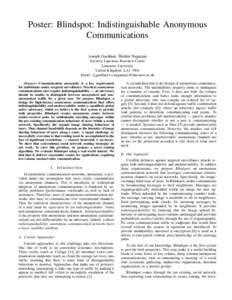<--- Back to Details
| First Page | Document Content | |
|---|---|---|
 Date: 2015-05-11 16:42:33Internet Tor Onion routing Network topology Routing ANts P2P Telecommunications network Communications protocol Internet privacy Computing Software |
Add to Reading List |
| First Page | Document Content | |
|---|---|---|
 Date: 2015-05-11 16:42:33Internet Tor Onion routing Network topology Routing ANts P2P Telecommunications network Communications protocol Internet privacy Computing Software |
Add to Reading List |